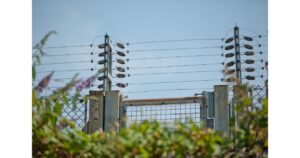Are you worried about how to train a dog to an electric fence, as your pet has grown big and needs a proper containment system? Electric fences are a great source of security for your dogs if you have a big yard.
Secondly, if you are concerned about home aesthetic appeal and don’t want to compromise it with other fencing systems like brick walls, etc. Even if you are among those owners who don’t want to spend too much money on the fencing system.
Electric dog fences are hassle-free dog containment with electric fences! Training your furry friend to understand the boundaries of an electric dog fence can be a significant change for both you and your pup.

Key Takeaways:
Table of Contents
ToggleI will provide you with an in-depth guide on how to train a dog to use an electric fence. You will get the answers on setting the electric dog fence, dog fence training, and related topics, so let us start.
What is an electric fence for dogs?
An electric fence for dogs is a system that uses a buried wire or wireless transmitter to create an invisible boundary around a specific area. The system includes a collar that your dog wears, which receives a radio signal from the wire or transmitter. If the dog crosses the boundary, it receives a mild electric shock through the collar. Over time, the dog learns to recognize the boundary and stays within it.
Setting Up the Electric Dog Fence
Dog Fence Setting up an electric dog fence is the first step toward creating a secure space for your pet. Begin by familiarizing yourself with the system—whether it’s a wireless or wired dog fence. Once it’s installed, it’s time to introduce your dog to the setup. Fitting the collar is crucial; let it be a positive experience for your dog. Engage in some initial playtime to create positive associations with the new accessory. Remember, a cheerful dog makes for a receptive learner!
Introducing the Dog to the Fence
With the setup complete, it’s time to introduce your dog to the invisible boundaries. Teaching your dog the warning signal is paramount. Start with the lowest correction level to ensure a gentle introduction. Gradually increase the level based on your dog’s response. Training your dog with distractions comes next; introduce controlled stimuli to mimic real-world scenarios. This step helps your dog associate the warning signal with various situations, ensuring consistent and reliable responses.
Off-Leash Training
Dreaming of a dog frolicking off-leash in the backyard? Off-leash training is the key to turning that dream into reality. Before jumping into this phase, ensure your dog is well-acquainted with the fence and its boundaries. During the testing compliance stage, prepare your dog for temptations like toys, the presence of family members, other dogs, and animals. Gradually increase the level of distractions, honing your dog’s ability to stay within the set boundaries.
Preparing for Electric Fence Training
Before training your dog to use an electric fence, there are a few things you need to do to prepare.
1: Choosing the right electric fence for your dog
Choose an electric fence that is appropriate for your dog’s size and temperament. Consider the range and features of the fence, as well as the cost and installation requirements. Research different brands and read electric dog fence reviews to find the best option for your needs.
2: Installing the electric fence
Follow the manufacturer’s instructions to install the electric fence. This may involve burying a wire or setting up a transmitter. Make sure the fence is installed correctly and test it before training your dog.
3: Setting up the boundary flags
Set up boundary flags around the perimeter of the electric fence to help your dog recognize the boundary. These flags should be placed at regular intervals and should be visible to your dog.
Tips for Effective Training
Want to elevate your electric dog fence training game? Discover additional insights and tips for successful training. From positive reinforcement techniques to understanding your dog’s unique learning style, these tips will make the training process more enjoyable for both you and your furry friend.
Training Your Dog to an Electric Fence
Training your dog to an electric fence takes time and patience. Follow these steps to train your dog to use an electric fence.
1: Introducing your dog to the electric fence
Introduce your dog to the electric fence by walking it around the perimeter on a leash. Let your dog sniff the boundary flags and explore the area. Use positive reinforcement, such as treats and praise, to create a positive association with the area.
2: Teaching your dog to recognize the warning beep
Most electric fences emit a warning beep before the dog receives a shock. Teach your dog to recognize this beep by walking it around the perimeter on a leash and stopping when it hears the beep. Use positive reinforcement to reward your dog for stopping.
3: Using positive reinforcement to train your dog
Positive reinforcement is a powerful tool in dog training, and it plays a crucial role in electric fence training. Celebrate your dog’s successes with treats, praise, and playtime. By associating correct behavior with positive experiences, you’re building trust and creating a positive connection between your dog and the boundaries set by the electric fence.
4: Tailoring Training to Your Dog’s Personality
Every dog is unique, and tailoring your training approach to your dog’s personality is essential for success. Some dogs may respond well to playful encouragement, while others may require a more gentle and patient approach. Pay attention to your dog’s cues and adjust your training methods accordingly. This personalized touch ensures a training experience that resonates with your furry friend.
How To Train A Dog To An Electric Fence.Tips for Training
Follow these tips to ensure successful electric fence training for your dog.
Consistency is key. Invisible Fence Training Schedule
Creating a consistent training schedule is vital for success. Dogs thrive on routine, so establishing a predictable training routine helps them understand boundaries faster. Stick to a schedule for training sessions, gradually increasing complexity as your dog becomes more adept at staying within the set boundaries. Consistency is the key to success!
Gradually increasing the correction level
Gradually increase the correction level of the electric fence collar as your dog learns to recognize the boundary. Start with the lowest level and only increase if necessary. Monitoring your dog’s behavior
Monitoring your dog’s behavior
Look for signs of stress or anxiety, and adjust the training as needed. Regularly checking the electric fence system
Regularly checking the electric fence system
Regularly check the electric fence system to ensure it is working. Check the collar battery, wire connections, and transmitted signal.
Troubleshooting training issues
Encountering challenges during electric fence training is normal, and our expert tips for troubleshooting will guide you through common issues. Whether it’s a collar malfunction, inconsistent signals, or behavioral concerns, these tips from seasoned trainers will empower you to address challenges effectively, ensuring a smooth training journey for both you and your dog.
1: Your dog is not responding to the warning beep
If your dog is not responding to the warning beep, try increasing the volume or changing the tone. Make sure the collar is properly fitted and the battery is charged.
2: Dog traumatized by electric fence
Encountering setbacks is normal during training, and if your dog becomes anxious or traumatized by the fence, it’s crucial to address the issue with patience and understanding. Reintroduce the training process slowly, using positive reinforcement to rebuild trust. Seek guidance from a professional dog trainer if needed, ensuring a positive and supportive environment for your furry friend.
3: Your dog is escaping the electric fence
If your dog is escaping the electric fence, check for holes or gaps in the boundary. Adjust the boundary flags and collar settings as needed.

Expert Opinion:
I have elaborated on all the information in terms of system understanding, precautions, and associated data. These steps can be validated on other reputable sites. The reference is given below.
https://www.wikihow.pet/Train-a-Dog-to-Use-an-Electric-Fence
Ethical and Regulatory Considerations
Ethical Consideration
Animal Welfare
Electric shock can cause discomfort to most dogs. So to be a responsible dog owner, use the lowest intensity of shocks and, secondly, only use it when necessary. Try to modify your training in such a way that positive reinforcement is enough to do the job.
Psychological Effects:
Electric fences can create anxiety in some dogs, especially those who are not familiar with it or have not been introduced properly. Be mindful of your dogs behavior in the process of adaptation and adjust your program accordingly.
Regulatory Considerations
Local Laws
Regulations regarding electrical fence installation can vary from state to state, so dog owners should check with their local authorities for the applicable laws.
Permissions
Some areas require permits for fencing systems and have specific requirements concerning height and material, so better to check in advance to avoid any issues.
Conclusion
I hope my readers will now easily understand how to train a dog on an electric fence. Training your dog on an electric fence takes time and patience, but it is an effective way to keep your dog safe and contained within a specific area.
Choose the right electric fence for your dog, install it correctly, and follow a consistent training schedule. Use positive reinforcement and escalate the correction level as your dog learns to recognize the boundary. Regularly check the electric fence system and monitor your dog’s behavior for signs of stress or anxiety. With proper training, your dog can learn to use an electric fence safely and effectively.
Frequently Asked Questions
Q: How to Take a Dog for a Walk with an Invisible Fence
Once your dog is trained and comfortable with the electric fence, taking them for a walk becomes a delightful experience. Use a leash during walks, gradually transitioning to off-leash adventures within the safety of the electric fence boundaries. This step ensures your dog understands the difference between supervised walks and free-roaming playtime in the designated area.
Q: Will the electric fence hurt my dog?
The electric stimulation from the fence is a deterrent and does not cause harm. Follow the recommended settings and gradually introduce the dog to the fence. Use positive reinforcement and clear boundaries. Proper training ensures that the dog understands the limits without experiencing excessive discomfort.
Q: How long does it take to train a dog to an electric fence?
The training duration varies depending on the dog’s temperament, responsiveness, and consistency of training. On average, it may take a few weeks to a couple of months to train a dog to respect the boundaries of an electric fence. Patience, consistency, and positive reinforcement are essential throughout the training process.
Q: What if my dog doesn’t respond to the electric fence training?
If your dog doesn’t seem to respond to the electric fence training, it’s best to consult with a professional dog trainer or behaviorist. They can assess your dog’s behavior and recommend alternative training methods. They can suggest modifications to the training process to ensure the safety and effectiveness of your dog.







